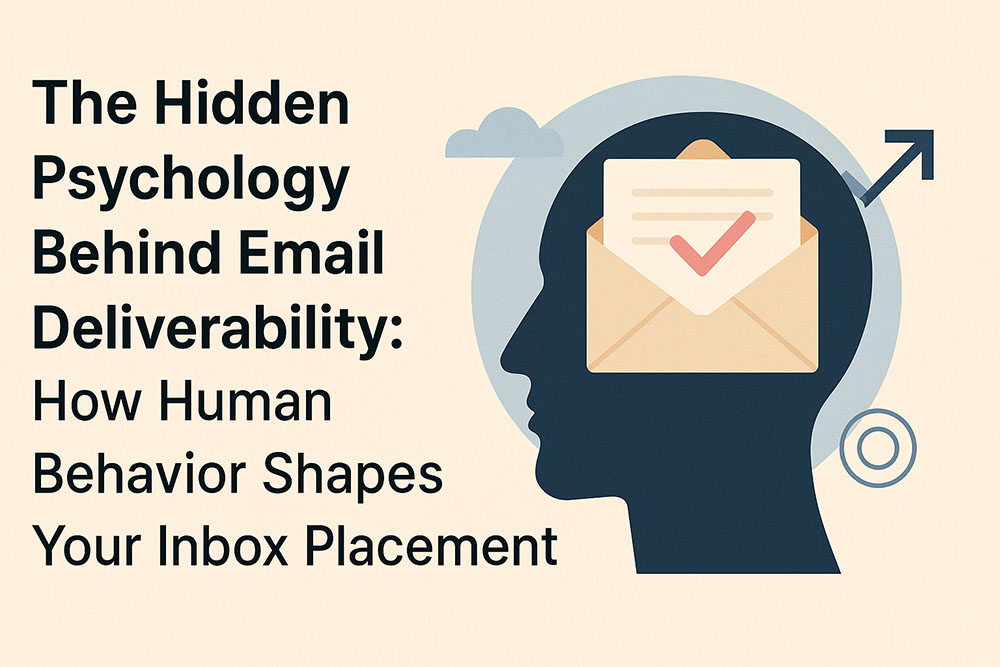
The Psychology of Email Interaction, and Why It’s the Hidden Key to Deliverability
Understanding how people interact with emails is no longer just about creative writing or clever design. It’s about psychology, trust, and timing.
Most marketers look at open rates and click rates as simple performance metrics. But behind every open, click, or delete is a decision.
When you understand what drives human behavior inside the inbox, you can dramatically improve both engagement and deliverability.
Behind every open, click, or delete is a subconscious choice, and those micro-decisions reveal how people truly respond to your brand.
When you learn to align with the way the human brain processes trust and emotion, you can transform not only your email engagement but your overall sender reputation.
So how exactly do people interact with marketing emails, consciously and subconsciously, and what does that mean for your deliverability?
Let’s break it down into seven key moments that shape every email’s success.
1. The First Three Seconds: Open or Ignore
Before a subject line is even fully read, the brain makes its call: Is this safe? Is this relevant? Is this worth my time?
That decision hinges on three things:
- Sender recognition: “Do I know and trust who this is from?”
- Subject line emotion: “Does this spark curiosity, relief, or transformation?”
- Preview text clarity: “Can I tell what I’ll gain if I open this?”
Within three seconds, the limbic system, the emotional center of the brain, decides whether to reward you with attention or protect itself by ignoring you.
What this means:
Consistency builds trust. Your “From” name, tone, and timing teach the brain you’re safe and familiar.
Clever wordplay won’t win the open, trust and relevance will.
2. The Seven-Second Scan: Stay or Delete
Once opened, most readers don’t read; they scan.
Eye-tracking studies show that people skim the top few lines, glance at images or bold text, and look for one clear takeaway.
If they can’t find it in seven seconds, they move on.
How to earn attention:
- Write short, conversational paragraphs.
- Bold the ideas you want remembered.
- Use whitespace to make scanning effortless.
- Present one clear, emotional call to action.
Your readers aren’t looking to read an email, they’re looking for a feeling: clarity, connection, or reward. Deliver that quickly, and they’ll stay.
3. The Emotional Filters Behind Every Decision
Every inbox choice, open, read, delete and click passes through three subconscious filters:
- Relevance: “Is this for me?”
- Trust: “Do I believe this sender has my best interest in mind?”
- Reward: “What will I gain by engaging?”
If any filter fails, the email is ignored.
Curiosity, relief, empowerment, and belonging are the emotions that drive engagement. Confusion or suspicion drive deletions.
Emotionally aligned messaging isn’t a creative luxury, it’s a deliverability strategy.
4. The Click: The “What’s In It For Me” Test
The click is not about the button, it’s about belief.
Before clicking, the reader subconsciously weighs:
- Effort: Is this worth my time?
- Risk: Will this link feel safe?
- Reward: Is this something I actually want?
That’s why the best CTAs are why-based, not command-based.
Instead of “Click here,” say:
- “See how your emails actually perform.”
- “Protect your sender reputation.”
- “Discover what’s holding back your deliverability.”
When the why is clear, the click becomes automatic.
5. Behavior Is the New Deliverability Score
Every open, click, and scroll sends a message to Gmail, Yahoo, and Outlook.
Mailbox providers track engagement like a human pulse:
- Positive signals—opens, clicks, replies, saves—improve reputation.
- Negative signals—deletes, ignores, spam flags—lower it.
That means your subscribers’ behavior directly shapes your inbox placement
Human engagement is now the algorithm.
6. The Post-Click Experience
The moment after the click is where trust is either reinforced or broken.
If your landing page loads fast, feels consistent with the email, and delivers value—trust deepens.
If it feels like a bait-and-switch, that trust evaporates, and future deliverability suffers.
Consistency between your message and your destination isn’t just good marketing—it’s signal hygiene.
Even your Thank You page plays a role. Teach new subscribers to check their inbox, whitelist your address, and look forward to your next send. That simple step can improve engagement metrics from day one.
7. The Human Takeaway: Deliverability Starts With Psychology
Every algorithmic decision mailbox providers make originates in one thing…human behavior.
People don’t engage with technology. They engage with emotion, clarity, and value.
They don’t want more emails, they want meaningful ones.
If you want your deliverability to rise, start where the decision really happens: inside the human brain.
Write for the person, not the platform.
Build trust before you ask for attention.
Deliver value before you ask for a click.
When people want your emails, mailbox providers will, too.
Quick-Action Checklist: Turn Insight Into Inbox Results
- Authenticate and Align: Use SPF, DKIM, and DMARC to protect your reputation.
- Send with Consistency: Keep a predictable cadence so your name feels familiar, not intrusive.
- Segment Intelligently: Mail recent engagers first; re-engage or sunset the rest.
- Write for the Scan: Short paragraphs, bold key lines, visible CTAs.
- Lead with Emotion: Use curiosity, relief, and empowerment over hype.
- Match Message to Destination: Align the landing page promise and tone with the email.
- Monitor Engagement: Watch clicks, replies, and time-on-email — they’re your real deliverability metrics.
Ready to see how your emails really perform?
Avoid Missing Out on Proven Results?
Book a Deliverability Review with Email Smart.
